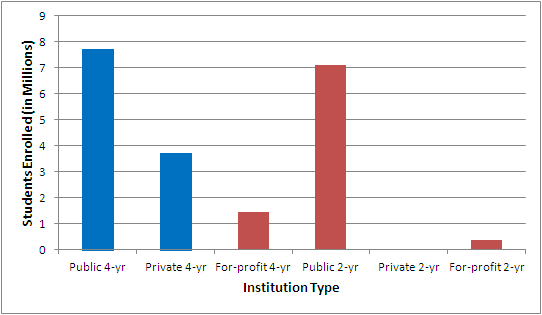In the popular imagination, college students are people who attend public or non-profit four year institutions. That is how the press depicts students, and those students are the primary constituency of student groups and movements. While it is true that these kinds of students are the majority, there are around 9 million students in other kinds of degree-granting institutions. Those 9 million students comprise 44 percent of the total student population.
Here is the complete breakdown:

The attendees of for-profits and public 2-year colleges come from poorer backgrounds, have higher rates of of indebted dropouts, and have seen the fastest rise in freshman borrowing rates. After graduation, these students have relatively worse job prospects, and their lifetime wage premiums are substantially lower than other types of students. In short, these basically invisible 9 million students face the highest levels of hardship.
Despite this, we see very little discussion of these students within the press and policy circles, and even less involvement of these students in student movements. Why these students are invisible, I do not really know. My speculation is that journalists and policy commentators are mainly graduates of four-year public and non-profit institutions. Their tendency to ignore other kinds of students reflects their experiences and understanding of what college means.
On the movement side of things, I could not begin to guess what keeps these 9 million students out. Whatever it is though, individuals seriously concerned about students and their hardships must find ways to include and engage this invisible half of the student population. Right now, the composition of student movement groups skews towards those who need student movements the least, a volatile situation which can quickly degrade into purity leftist posturing.